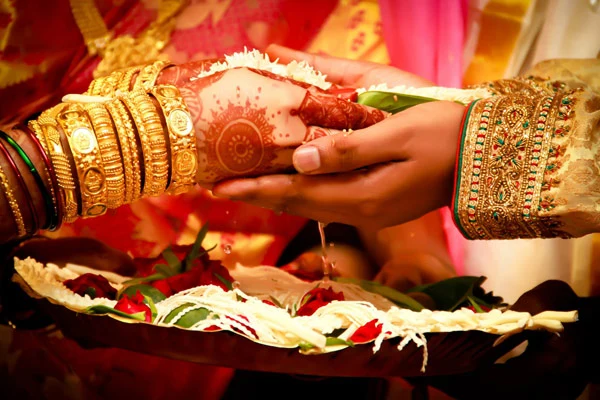Our Puja
Home
Vivah Puja
Vivah Puja, also known as the wedding ceremony or marriage ritual, is a sacred and significant event in Hindu culture.
The steps and rituals may vary based on regional and cultural differences, but here is a general outline of the Vivah Puja ceremony:

Ganesh Puja (Ganpati Puja):
- The ceremony often begins with the worship of Lord Ganesha, the remover of obstacles. This is done to seek his blessings for a smooth and obstacle-free wedding.
Punyahavachan:
- This ritual involves purifying the surroundings and the individuals involved in the wedding. Mantras are chanted, and holy water is sprinkled to purify the environment.
Matruka Puja:
- Matruka Puja involves the worship of the seven mother goddesses, symbolizing fertility and protection. It is performed to seek the blessings of these goddesses for a prosperous and harmonious married life.
Vivah Mandap Puja:
- The wedding mandap (canopy) is considered a sacred space. The priest performs rituals to consecrate the mandap and seeks the blessings of deities for the couple.
Vara Puja (Groom’s Puja) and Kanya Puja (Bride’s Puja):
- The bride and groom are individually worshipped by their respective families. The groom is considered an embodiment of Lord Vishnu, and the bride is seen as Goddess Lakshmi. They are adorned with flowers and traditional attire during this puja.
Sankalp (Vow):
- The priest and the couple together make a vow to conduct the marriage ceremony with purity and sincerity.
Kanyadaan:
- The father of the bride gives away his daughter to the groom. This is considered one of the most emotional moments in the ceremony.
Vivah Homa:
- The sacred fire (agni) is lit, and offerings are made into the fire while reciting Vedic mantras. The fire is considered a witness to the ceremony.
Pheras (Circumambulation):
- The couple takes seven rounds around the sacred fire, each round symbolizing different marital vows and commitments.
Saptapadi:
- The couple takes seven steps together, each step representing a vow and commitment to each other.
Mangalsutra and Sindoor:
- The groom ties the mangalsutra (sacred thread) around the bride’s neck, symbolizing their marital bond. The groom also applies sindoor (vermilion) on the bride’s forehead.
Ashirvad (Blessings):
- The elders and the priest bless the couple for a happy and prosperous married life.


Remember that specific customs and rituals may vary among different communities and regions within the Hindu culture. It’s essential to consult with the priest or religious leader conducting the ceremony for the most accurate guidance based on your particular tradition.
